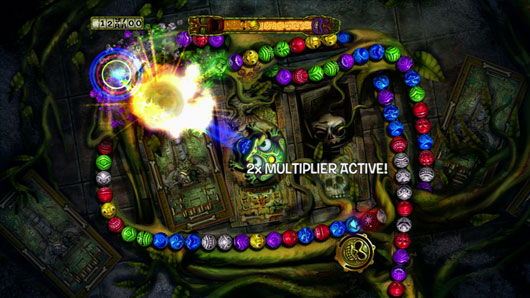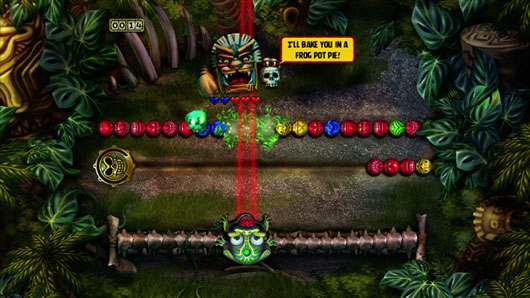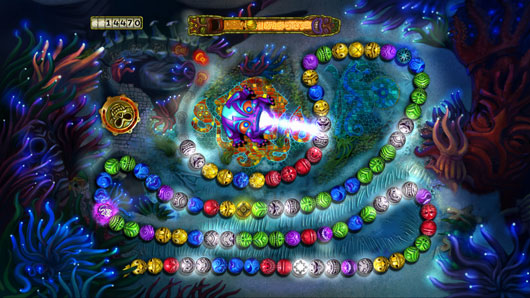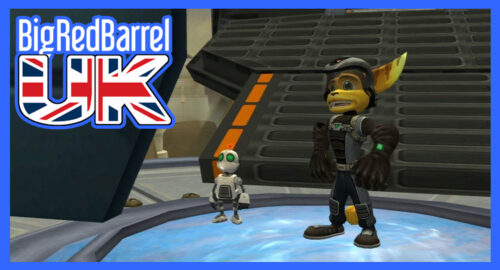Zuma’s Revenge looks to refine the formula set down in Pop Cap’s original Zuma release. It is an iteration on the previous design and certainly is not looking to redefine the match-three style gameplay that made Zuma a simplistic gameplay success before it. Given the amount of time since the previous release, it’s difficult to see exactly what is different about this new version of the game. The HD respray is more overtly obvious than the changes to gameplay, but these under-the-hood changes become ever clearer as you delve deeper in to the jungle of new features and additions.
• Developer: Pop Cap Games
• Publisher: Pop Cap Games
• Reviewed on: XBLA
• Also Available On: PC, iOS, DS
• Release Date: Available Now

In the previous version of Zuma, every level had a slight variation but stuck to the central theme of having a rotating frog located somewhere in the middle of a line of ever advancing rotating spheres (or stones as they are called). Matching three or more stones will see them disappear from the screen, with bonuses such as reversing the flow or slowing down the speed of advancement being triggered if one of the stones you’ve just cleared is marked with the corresponding symbol. In the majority of modes a player can achieve “Zuma” by reaching a point total; reaching this total stops more stones from being released, leaving you with the task of clearing the remaining stones in order to progress to the next level. The concept of having lives that existed in the previous Zuma game has been scrapped and any level can now be retried at any time.

Zuma’s Revenge adds two new gameplay styles to the traditional Zuma formula. Some levels now have two lilly pads to house your frog, giving you two angles of attack, with others having a horizontal or vertical slider that houses your frog, meaning that you are free to move either up and down or left and right to your heart’s content, but are unable to not reorient your angle. Having two points to launch your frog-spitting stones from does add another dimension and, despite the slider levels feel somewhat more restrictive, both add some welcome variation to the gameplay and also have some unique achievements attached to them. New power-ups make their debut, giving you the ability to kit yourself out with lasers to blast individual stones or lighting that will wipe all of one colour off the board. Multiplier balls – which work in a similar way to the bonuses – are also a new addition and, unsurprisingly, help with the task of maxing out your score.
One of the biggest and more noticeable changes to the adventure mode of Zuma is the addition of boss fights; these see you squaring off against a boss character at the top of the screen with your frog, who’s perched on a slider at the bottom. You must wear down their energy, usually by hitting them with your stones, but this is made more difficult in a couple of interesting ways. Firstly, there’s a line (or two depending how badly doing or slowly you are going) of stones in the middle of the screen that need to be made to vanish to create gaps to shoot through; this is then made more tricky by a variation of challenges, the nature of which are dependent on the boss you are facing. Some challenges require you to strike the boss’ minions before you can actually deal out damage to the boss and others will shoot back at you with negative effects should you be hit. Again, this is adds a nice bit of variation to the mix and there is an unlockable ‘boss rush’ mode, accessible from the main menu.

There’s also a number of unlockable Spirit Guide bonuses that you can get your mitts on by spending the coins that you’re awarded for successfully completing levels and, if you’re a bit of a show-off, meeting a target times and/or scores. Four Spirit Guides unlock as you progress through the game and give you access to bonuses such as an overall percentage score boost or an increase in shot speed. Any coins that you invest in your spirit guides are non-permanent and you can easily switch up how much cash you’re diverting to – and the degree of bonus you get from – a particular Spirit Guide by raising or lowering the totem poles that they sit on.
The addition of a weekly challenge section, whilst a good idea, doesn’t seem to add too much to the game as it just seems to set a score challenge on an existing level. The majority of the achievements are not very hard to unlock as you progress through the game, and most of the replay value will doubtless come from trying to beat your friends (and the rest of the world) in the online leaderboards. Strangely, the leaderboards were the source of the only technical hitch that I came across when playing through Zuma’s Revenge, as they seemed a little jittery over the launch weekend. That being said, I’d imagine that this the issues with the leaderboards will be a short-term problem that will sort itself out as the volume of scores being posted level off a bit or through software patches. In all fairness, I’m probably only nitpicking as this isolated problem really didn’t affect my enjoyment of the game in the slightest. If all the game modes I’ve already mentioned aren’t enough for you, then there’s also an ‘Iron Frog’ mode that features ten very hard levels that have to be completed in succession and will doubtless pose a challenge even for the most experienced Zuma players.
UPDATE: In the last 24 hours the leaderboards have been perfectly well behaved and so, hopefully have already eliminated this issue. ZUMA!
Zuma’s Revenge adds some layers of depth to an otherwise simplistic but enjoyable puzzle game that’s ridiculously easy to become fairly addicted to. For me, it didn’t quite reach the levels of Pop Cap’s greatest achievements – Plants vs. Zombies and Peggle – but is nevertheless a very enjoyable, one-more-go inducing puzzle game and, as such, makes it a very easy recommendation. The only proviso that comes with is that Zuma’s Revenge is available to play online for free via PC. That said, the addition of leaderboards, achievements and the ability to enjoy the game from the comfort of your couch with some controller refinements and game mode additions should be enough to still make this a worthy of the 800 Microsoft Point price tag.

